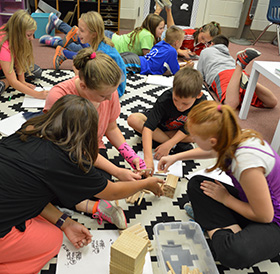Four years ago, Cedar View fifth grade teachers Jennifer Kahler and Erin Cairy switched the traditional teaching style of explaining math concepts and helping students as they worked individually to what they call “Collaborative Math.”
Fifth grader Colten Schreiner knows why it is important to work in groups. “When you work with others, some people know other stuff you don’t, and they can help you figure out what you need to know,” he said during a recent collaborative math class.
“I think it helps and it is exciting,” added classmate Trinity Collin. “Really good can come from many ideas.”
Collaborative math came out of a frustration that even to the teachers, the math portion of the day was somewhat boring, said Cairy.
“We were feeling frustrated when it came to math time,” she said. “The classroom was lacking the energy and enthusiasm that we had in other areas.”
The teacher duo “brought problem solving back into math, said Cairy. “We don’t teach strategies but let them play with it. When we let them find a way to make math work – the energy went through the roof.”
“It doesn’t get boring when you work with other people,” said fifth grader Ellie Bowser.

Problem-solving is good brain work
But collaborative math is more than “not boring,” it teaches students to think. “The ‘collaborative challenge” portion of our math workshop started when we noticed our students need for critical thinking and problem solving,” said Kahler. “We added this into our time so that students would have the opportunity to think about the ‘why’ behind their math lesson rather than just sit and get information.”
Students are given a problem, then divided into groups to figure out how to solve it. A recent lesson asked to figure out how much money a person needed to take on an outing. They were given the basic scenario, a series of numbers and several possible answers. Groups were challenged to figure out the correct “order of operations,” in order to get the final answer.
When they are in groups, “they are able to play around with math ideas and build thinking off of others’ ideas,” said Kahler.
Some students, like Michael Stevens, were quite confident about the daily problem. ” I am 100 percent I know this – actually I am 102 percent,” he said. “I learned the order of operation before and I know I am right – you always do multiplication and division before adding and subtracting.”
Others were convinced that in order to solve the problem, they needed more information about what the numbers they were given meant.
“I think that it helps (to work in groups) a lot,” said Joseph KLinge. “Sometimes you can figure it out with other people when you don’t agree with you. And it helps you remember after.”
Kahler agrees. “Ultimately their thinking is deeper and more connected because it’s coming from them,” she said.
Using a group thinking method for teaching math is “very encouraging” according to Cairy, who realizes that some of the fifth graders may have been exposed to it before.

Working together works
A ‘workshop’ method for teaching math in second grade at Beech Elementary has produced some “remarkable results,” according to teachers there.
The math workshop places more emphasis on thought process than on the answers. When students are given a story problem, their job is to figure out what’s important and decide on different ways to solve it. Beech teachers fashioned that program after observing a classroom at another elementary school.
The “Math Collaborative” at Cedar View is based on the same concept, but formatted a little differently and emphasizing the collaboration, according to Cairy. The teachers help students discover math strategies while working together.
Cairy said she was even more convinced that the method she and Kahler have embraced is on the right track, after a recent encounter with a former student, who is now in middle school and has some academic struggles. “I really miss the way you teach math,” he told her.
Connect











